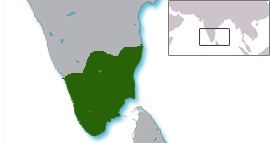5th century Achyutavikranta | Historical era Classical India | |
 | ||
Religion BuddhismHinduismJainism | ||
The Kalabhra dynasty (Kalappirar in Tamil) ruled over the entire ancient Tamil country between the 3rd and the 7th century in an era of Tamil history called the Kalabhra interregnum. The Kalabhras, possibly Jain, displaced the kingdoms of the early Cholas, early Pandyas and Chera dynasties by a revolt. The Kalabhras put an end to the Brahmadeya rights granted to the Brahmins in numerous villages across southern India.
Contents
- Identification
- Evidence from literature
- Reasons for the unpopularity
- Patrons of literature
- Religion
- Fall of the Kalabhras
- References
Information about the origin and reign of the Kalabhras is scarce. They left neither artefacts nor monuments, and the only sources of information are scattered mentions in Sangam, Buddhist and Jain literature. The Kalabhras were defeated by the joint efforts of the Pallavas, Pandyas and Chalukyas of Badami.
Identification
The origin and identity of the Kalabhras is uncertain. They are generally believed to have been hill tribes that rose out of obscurity to become a power in South India. Their kings were likely followers of Buddhism and Jainism. Some of their coins feature images such as a seated Jain monk, the Buddhist Bodhisattva Manjushri, or the Swastika symbol, with Prakrit inscriptions in Brahmi script on the other side. Later specimens dating towards the 6th century employ both Prakrit and Tamil in their inscriptions and feature images of Hindu gods and goddesses.
A number of theories have been advanced for the identity of the Kalabhras. T. A. Gopinath Rao equates them with the Muttaraiyars, and Kallars and an inscription in the Vaikunta Perumal temple at Kanchi mentions a Muttaraiyar named as Kalavara-Kalvan. The word Kalabhra might possibly be a Sanskrit derivation of the Tamil Kalvan. M. Raghava Iyengar, on the other hand, identifies the Kalabhras with the Vellala Kalappalars. The c. 770 Velvikudi plates of the Pandyan king Parantaka Nedunjadaiyan mention the Kalabhras and R. Narasimhacharya and V. Venkayya believe them to have been Karnatas. K. R. Venkatarama Iyer suggests that the Kalabhras might have settled in the Bangalore-Chittoor region early in the 5th century.
Evidence from literature
The history of Cholas of Uraiyur (Tiruchirappalli) is exceedingly obscure from 4th to the 9th century, chiefly owing to the occupation of their country by the Kalabhras. Buddhadatta, the great writer in Pali, belonged to Uraiyur. He mentions his contemporary, King Achyutavikranta of the Kalabharakula, as ruling over the Chola country from Kaveripumpattinam. He was a Buddhist. Tamil literary tradition refers to an Achyuta who kept the Chera, Chola and Pandya rulers in captivity. On the basis of the contemporaneity of Buddhadatta with Buddhaghosha, Achyuta may be assigned to the 5th century. Thus, after the Sangam age, the Cholas were forced into obscurity by the Kalabhras, who disturbed the placid political conditions of the Tamil country.
Reasons for the unpopularity
Kalabhras, by ruling the Tamil country, disturbed the prevailing order. The Velvikudi inscriptions of the third regnal year of Pandya ruler Nedunjadaiyan (c. 765 – c. 815) say that Pandya ruler Mudukudumi Peruvaludi gave the village of Velvikudi to the Tamil scholars . They enjoyed it for a long time. Then a Kali king named Kalabhran took possession of the extensive earth, driving away numberless great kings.
Patrons of literature
The period of Kalabhras was marked by the ascendancy of Buddhism, and probably also of Jainism. It was characterized by considerable literary activity in Tamil. Most of the works grouped under the head, "The Eighteen Minor works" might have been written during this period as also the Silappadhikaram, Manimegalai and other works. Many of the authors were characterised as belonging to the "heretical" sects (meaning Buddhists and Jains). However, the great Tamil lexicographer Vaiyapuri Pillai had ascribed later dates to many of these works. This theory would undermine the link between the Kalabhras and the "Eighteen Minor works".
Religion
It is known that the Kalabhras patronised Hinduism, Buddhism and Jainism. The late Kalabhras appear to have been Shaivite and Vaishnavite. Scholar F. E. Hardy traced the palace ceremony to a Vishnu or Mayon temple to the rule of the Kalabhras. They are known for patronising the Hindu god, Skanda or Subramanya. They imprinted his image on their 5th-century coins, especially those of the Kaveripumpattinam rulers. King Achyuta worshipped Vaishnava Tirumal.
Fall of the Kalabhras
The rule of the Kalabhras of South India was ended by the counter-invasions of Pandyas, Chalukyas and Pallavas. There are other references to the Kalabhras in Pallava and Chalukya inscriptions. They were conquered by Pallava, Simhavishnu and Pandya, Kadungon.
